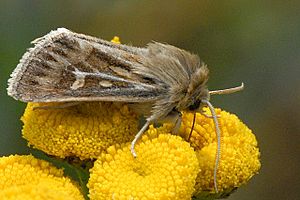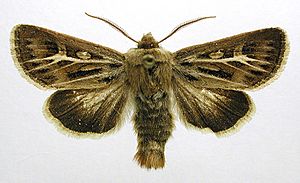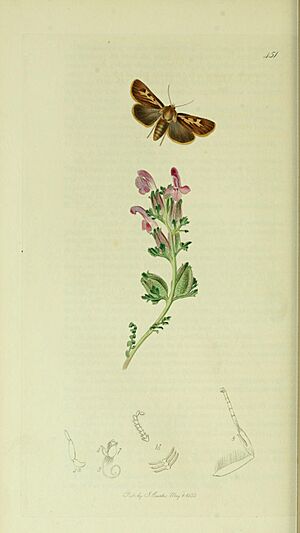Antler moth facts for kids
Quick facts for kids Antler moth |
|
|---|---|
 |
|
 |
|
| Scientific classification | |
| Genus: |
Cerapteryx
|
| Species: |
graminis
|
| Synonyms | |
|
|
The antler moth (Cerapteryx graminis) is a common type of moth from the family Noctuidae. It lives across most of Europe, but not in very dry southern areas. You can find it as far north as Iceland and even above the Arctic Circle. It also lives in Siberia and northern Mongolia. This moth has also been introduced to North America. In the Alps mountains, it can be found at heights up to 2,100 meters (about 6,900 feet).
Contents
What Does the Antler Moth Look Like?
The antler moth is special because the males and females look quite different in size. This is called sexual dimorphism. Male moths have a wingspan of about 27–32 millimeters (1.1–1.3 inches). But the females are much bigger, with a wingspan of 35–39 millimeters (1.4–1.5 inches).
Their front wings are brown with small black spots. They have a clear white mark near the base that looks like a branched antler. This is how the moth got its common name! The back wings are dark brown with a white edge.
Antler Moth Habits and Behavior
This moth often flies during the day, especially when the weather is warm. It likes to visit many different kinds of flowers. The antler moth also flies at night and is attracted to lights. Adult moths are usually seen flying from July to September.
Life Cycle of the Antler Moth
The antler moth starts its life as an egg. The species spends the winter as an egg. When the eggs hatch, a grey larva (caterpillar) emerges. This larva eats various types of grass, including Deschampsia, Festuca, and Nardus. Sometimes, there are so many larvae that they can damage pastures where animals graze.
Images for kids



